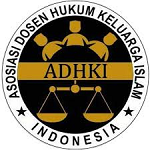The Nasab of A Corpse to Its Mother in the Practice of Talkin in Keudah-Malaysia and Aceh-Indonesia
Nasab Mayat Kepada Ibunya Dalam Praktik Talkin Di Keudah-Malaysia Dan Aceh-Indonesia
DOI:
https://doi.org/10.22373/hadhanah.v4i2.6020Keywords:
Talkin Corpse, Lafaz Talkin, Living HadithAbstract
Talking to the corpse is a tradition that has been practiced for a long time in Islamic society in the archipelago, the form of implementation is very diverse. The naming of the corpse in the practice of talking to the mother is different from the lineagein fiqh which is generally referred to the father. The use of pronunciation is also different, the Kedah Malaysian community carries out talking using Malay, while the Acehnese community in Indonesia uses Arabic. This study answers the background of the differences in the use of the talkin phrase in Kedah-Malaysia and Aceh-Indonesia and the reference basis used. Answering this objective, interviews were conducted with several religious figures and observations were made on the talkin activities and relevant documents were reviewed. After obtaining qualitative data, the data were then compared using comparative analysis. The results of the study found that the process of implementing talking between Kedah-Malaysia and Aceh-Indonesia was almost the same, but in the use of the talkin phrase by the Kedah-Malaysian community using Malay which was adopted from the hadith narrated by al-Ṭabrānī in a visible way as their reference. Meanwhile, in Aceh-Indonesia, they practice the reading of talkin the corpse in the History of al-Ṭabrānī, but in narrating the corpse using the concept of lineage in fiqh because the aim is to make it easier. Ulama Keudah Malaysia and Aceh admit that narrating the corpse to the mother in the practice of talkin is more important than to the father.
References
Abadi, Muhammad Syams al-Haq al-‘Adhim. ‘Awn al-Ma’Bud Sharh Sunan Abi Dawud. Mesir: Maktanah al-Salafiyyah, 1969.
Abbas, Sirajuddin. 40 Masalah Agama 4. Jakarta: Pustaka Tarbiyah Baru, 2013.
Al-Asqalāni, Ibn Ḥajar. Fatḥ Al-Bārī Bi Syarḥ Ṣaḥīḥ al-Bukhārī. Riyadh: Dār Ṭayyibah, 2005.
Al-Asqalānī, Ibn Ḥajar. Mausū’ah al-Ḥāfiẓ Ibn Ḥajar al-’Asqalānī al-Ḥadīṡiyyah. Madinah: Silsilah Iṣdārāt al-Ḥikmah, 2002.
———. Talkhīṣ Al-Ḥabīr Fī Takhrīj Aḥādīṡ al-Rāfi‟ī al-Kabīr. t.tp: Mu‟assasah al-Qurṭubah, 1995.
Al-Bukhārī, Muḥammad bin Ismā‟īl. Ṣaḥiḥ Al-Bukharī. Riyadh: Bait al-Afkār al- Dauliyyah Linnasyr, 1998.
Al-Dimyāṭī, Muḥammad Syaṭṭā. I’ānah al-Ṭālibīn. Beirut: Dār Iḥyā’ al-Kutb al-’Arabiyyah, n.d.
Al-Haiṡamī, Nūr al-Dīn. Majma‟ Al-Zawā‟id Wa Manba‟ al-Fawā‟id. Riyadh: Dār al-Minhāj, 2015.
Al-Jauhari, Jainal Sakiban. Talkin Dan 100 Buah Kitab Menolak Fahaman Wahabi. Johor Bahru: Majlis Agama Islam Johor, 2008.
Al-Malībārī, Abd al-Azīz al-Ma’barī. Fatḥ Al-Mu’īn Bi Syarḥ Qurrah al-’Ain Bi Muhimmāt al-Dīn. Beirut: Dār Ibn Ḥazm, 2004.
Al-Nawawī, Syarf. Al-Adzkar Mi Kalami Sayyidil Abrar. Beirut: Maktabah Asyriyyah, n.d.
———. Majmū‟ Syarḥ Al-Muhazżab Li al-Syairāzī. Riyadh: Al-Irsyad, 1925.
Al-Qaraḍāwī, Yūsuf. Al-Ḥalal Wa al-Ḥarām Fī al-Islam. Jakarta: Qalam, 2017.
Al-Qusyairī, Abū al-Ḥusain Muslim al-Ḥajjaj. Ṣaḥiḥ Muslim. Riyadh: Bait al-Afkār al-Dauliyyah, 1998.
Al-Sajsatani, Abu Dawud Sulaiman ibn Asy’ab. Sunan Abi Dawud. Riyadh: Maktanah Al-Ma’arif, 1420.
Al-Sindi, Abī al-Ḥasan. Fatḥ Al-Wadūd Fī Syarḥ Sunan Abī Dāwud. Mesir: Maktabah Līnah, 2010.
Al-Subkī, Maḥmūd Muḥammad Khaṭṭāb. Al-Manhal al-Ażb al-Maurūd Syarḥ Sunan al-Imām Abī Dāwud, Juz 9. Beirut: Muasu’ah al-Tārīkh al-Arabī, 1394.
Al-Ṭabrānī, Sulaimān bin Aḥmad. Al-Mu‟jam al-Kabīr. Mesir: Maktabah Ibn Taimiyyah, n.d.
———. Kitāb Al-Du’ā’. Beirut: Dār al-Basyā‟ir al- Islāmiyyah, 1987.
Al-Zuḥailī, Wahbah Muṣṭafā. Al-Mu’tamad Fī Fiqh al-Syāfi’ī. Jakarta: Gema Insani Press, 2018.
Al-Zuhaily, Wahbah. Al-Fiqh Al-Islami Wa Adillatuh. Beirut: Dar al-Fikr, 2008.
Atabik, Ahmad. “He Living Qur’an: Potret Budaya Tahfiz Al-Qur’an Di Nusantara.” Jurnal Penelitian 8, no. 1 (2014).
Aziz, Nasaiy, and Mukmsal Mina. “Nasab Anak Yang Lahir Di Luar Nikah: Analisis Fatwa MPU Aceh Nomor 18 Tahun 2015 Dan Keputusan MK Nomor 46/PUU/VIII/2010.” Samarah: Jurnal Hukum Keluarga Dan Hukum Islam 1, no. 1 (2017).
Ayyub Kadriah, “Analisis Kritis Ilmu Hukum Plural Terhadap Metode Hukum Komparatif Dan Komparasi Hukum.” Pamulang Law Review, Vol. 5, No. 2, (2022).
Siti Hajar, et al. “Maqasid Syariah in Islamic Consumption.” International Journal of Business and Economy (IJBEC) Vol.2, No. 4, (2020).
Jamil, M. “NASAB DALAM PERSPEKTIF TAFSIR AHKAM.” Ahkam XVI, no. 1 (2017).
Majelis Agama Islam Negara Kedah Darul Iman. Kaifiyah Sembahyang Dan Talkin Mayat. Kedah Daruk Iman: Percetakan Siaran, n.d.
Maulida, “Teknik Pengumpulan Data Dalam Metodologi Penelitian,” Darussalam, 21, (2020).
Mulqan, Ibn. Al-Badr al-Munīr Fī Takhrīj al-Aḥādiṡ Wa al-Aṡar al-Wāqi‟ah Fī al-Syarḥ al-Kabīr. Edited by Usāmah bin Aḥmad dan Abdullāh bin Sulaimān. Madinah: Dār al-Ḥijrah, n.d.
Permana, Dede. “Berinteraksi Dengan Hadis Dha’if Dalam Kehidupan Sehari-Hari.” DIRAYAH: Jurnal Ilmu Hadis, Vol. 1, No. 1, (2020).
Peter Mahmud Marzuki, Penelitian Hukum, Jakarta: Kencana, 2011.
Sabiq, Sayyid. Fiqh Al-Sunnah. Jakarta: Republika, 2018.
Sarong, Hamid. Hukum Perkawinan Islam Di Indonesia. Banda Aceh: Yayasan PeNA, 2010.
Somad, Abdul. 37 Masalah Populer. Pekanbaru: t.tp, 2014.
Sugiyono, Memahami Penelitian Kualitatif, Bandung: CV. Alfabeta, 2009.
Taufiqurrahman, Abu. Majmu’ Syarīf,. Semarang: Toha Putra, 2004.
Downloads
Published
How to Cite
Issue
Section
License
Copyright (c) 2024 Faisal Yahya, Muhammad Faiyadh Bin Faiz, Sri Wahyuni

This work is licensed under a Creative Commons Attribution 4.0 International License.

















